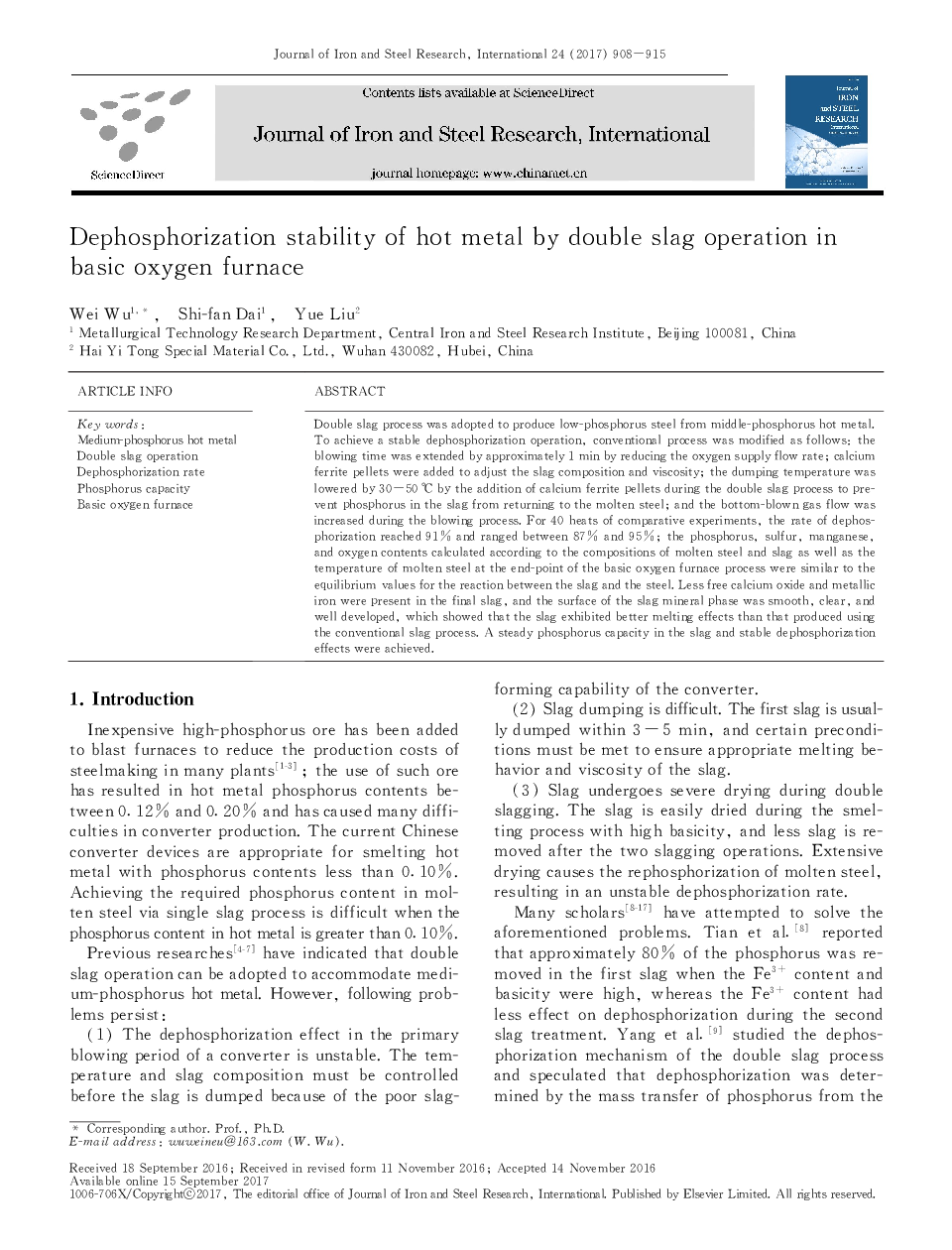| کد مقاله | کد نشریه | سال انتشار | مقاله انگلیسی | نسخه تمام متن |
|---|---|---|---|---|
| 8004191 | 1516577 | 2017 | 8 صفحه PDF | دانلود رایگان |
عنوان انگلیسی مقاله ISI
Dephosphorization stability of hot metal by double slag operation in basic oxygen furnace
ترجمه فارسی عنوان
پاکسازی ضریب فشرده سازی فلز داغ با استفاده از دو نوع سرباره در کوره اکسیژن پایه
دانلود مقاله + سفارش ترجمه
دانلود مقاله ISI انگلیسی
رایگان برای ایرانیان
کلمات کلیدی
فلز گرم متوسط فسفر، عملیات دو سرباره، میزان فسفردن، ظرفیت فسفر، کوره اکسیژن پایه،
ترجمه چکیده
برای تولید فولاد کم فسفر از فلز داغ هیدروژن فسفر، از دو روش سرباره استفاده شد. برای رسیدن به یک عملیات فسفریزاسیون پایدار، فرآیند متعارف به شرح زیر اصلاح شد: زمان خنک شدن با تقریبا 1 دقیقه با کاهش جریان جریان اکسیژن افزایش یافت؛ گلوله های فریت کلسیم برای تنظیم ترکیبات سرباره و ویسکوزیته اضافه شدند. دمای دمپایی با افزودن پودرهای فریت کلسیم در طی فرایند دو برابر 30 تا 50 درجه سانتیگراد کاهش پیدا کرد تا از فسفر در سرباره از بازگشت به فولاد مذاب جلوگیری شود. و جریان جریان گاز پایین در جریان دمیدن افزایش یافت. برای 40 گرم آزمایشات مقایسه، میزان دففسورزایی به 91٪ رسید و بین 87 تا 95٪ متغیر بود. مقدار فسفر، گوگرد، منگنز و اکسیژن محاسبه شده بر اساس ترکیبات فولاد مذاب و سرباره و همچنین دمای فولاد مذاب در نقطه پایان فرایند کوره اکسیژن اولیه مشابه مقادیر تعادلی واکنش بین سرباره و فولاد. اکسید کلسیم کمتر و آهن فلزی در سرباره نهایی وجود داشت و سطح فاز معدنی سرباره صاف، روشن و به خوبی توسعه یافته بود، که نشان داد که سرباره اثرات ذوب بهتر از آنچه که با استفاده از فرآیند سنتز سنتز تولید شده است. ظرفیت فسفر ثابت در سرباره و تأثیرات پاکسازی پایدار به دست آمد.
موضوعات مرتبط
مهندسی و علوم پایه
مهندسی مواد
فلزات و آلیاژها
چکیده انگلیسی
Double slag process was adopted to produce low-phosphorus steel from middle-phosphorus hot metal. To achieve a stable dephosphorization operation, conventional process was modified as follows: the blowing time was extended by approximately 1 min by reducing the oxygen supply flow rate; calcium ferrite pellets were added to adjust the slag composition and viscosity; the dumping temperature was lowered by 30-50 °C by the addition of calcium ferrite pellets during the double slag process to prevent phosphorus in the slag from returning to the molten steel; and the bottom-blown gas flow was increased during the blowing process. For 40 heats of comparative experiments, the rate of dephosphorization reached 91% and ranged between 87% and 95%; the phosphorus, sulfur, manganese, and oxygen contents calculated according to the compositions of molten steel and slag as well as the temperature of molten steel at the end-point of the basic oxygen furnace process were similar to the equilibrium values for the reaction between the slag and the steel. Less free calcium oxide and metallic iron were present in the final slag, and the surface of the slag mineral phase was smooth, clear, and well developed, which showed that the slag exhibited better melting effects than that produced using the conventional slag process. A steady phosphorus capacity in the slag and stable dephosphorization effects were achieved.
ناشر
Database: Elsevier - ScienceDirect (ساینس دایرکت)
Journal: Journal of Iron and Steel Research, International - Volume 24, Issue 9, September 2017, Pages 908-915
Journal: Journal of Iron and Steel Research, International - Volume 24, Issue 9, September 2017, Pages 908-915
نویسندگان
Wei Wu, Shi-fan Dai, Yue Liu,
